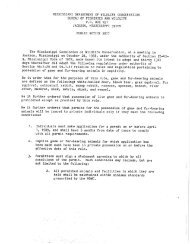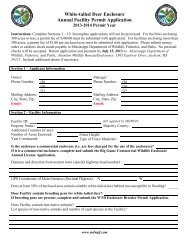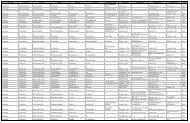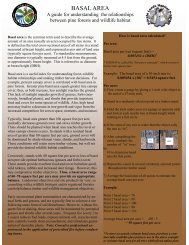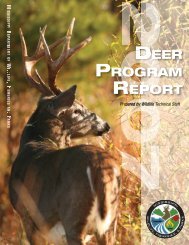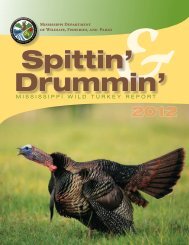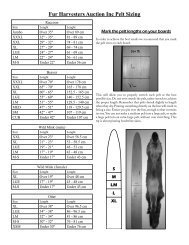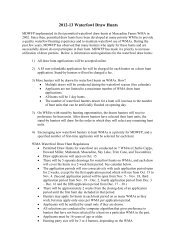Alligator Dispatch Techniques
Alligator Dispatch Techniques
Alligator Dispatch Techniques
Create successful ePaper yourself
Turn your PDF publications into a flip-book with our unique Google optimized e-Paper software.
<strong>Dispatch</strong>ing <strong>Techniques</strong><br />
<strong>Alligator</strong>s may only be dispatched with a shotgun with shot size no larger than #6 shot or with a<br />
bangstick chambered in .38 caliber or larger. All shotguns or bangsticks must remain cased and<br />
unloaded until the alligator is restrained. No alligator may be dispatched until it is restrained by<br />
a noose or snare around the neck or leg so that the alligator is controlled.<br />
Once the alligator has been restrained, it may be dispatched with legal equipment. A good rule<br />
of thumb is to dispatch the animal when it no longer thrashes after tugging on the restraining line<br />
2-3 times. This will ensure a still and safe target for dispatching with the shotgun or bangstick.<br />
To safely and humanely dispatch the alligator aim for the center of the spine directly behind the<br />
skull plate. Do not shoot through the skull plate. The skull of an alligator is very dense bone<br />
and fragments may ricochet. The brain, which is about the size of a walnut, is located 2-3 inches<br />
behind the eyes directly between the ear flaps. A properly placed projectile will sever the spinal<br />
cord and brain causing instant death. Never attempt to dispatch an alligator by shooting into the<br />
chest cavity. The use of safety glasses is recommended when discharging any firearm or<br />
bangstick.<br />
Shotgun<br />
After the alligator has been properly restrained, remove the shotgun from the case, place all<br />
persons in a safe location, and safely load the shotgun. While gentle pressure is kept on the<br />
restraining line to hold the head and neck above the surface of the water, place the end of the<br />
barrel of the shotgun a maximum of 6 to 8 inches from the alligator, directly above the neck .<br />
Aim for the very center of the neck (directly between the two center rows of scutes) at an angle<br />
slightly towards the base of the head. After properly firing the shotgun, the alligator will<br />
immediately relax and begin to sink. Follow directions located in the “Transporting from the<br />
Field.”<br />
Bangsticks<br />
After the alligator has been properly restrained, remove the bangstick from the case, place all<br />
persons in a safe location, and safely load the bangstick. Extreme caution should be used when<br />
handling any bangstick to insure that the safety pin is not removed until fully prepared to<br />
dispatch the alligator. Always follow manufacturer’s safety recommendations. A loaded<br />
bangstick should always be held over the side of the boat and pointed away from the boat. A<br />
bangstick should always be discharged below the water surface to reduce potential for aerial<br />
dispersal of bullet or bone fragments.<br />
While gentle pressure is kept on the restraining line to hold the head and neck slightly below the<br />
surface of the water, aim for the very center of the neck (directly between the two center rows of<br />
scutes) at an angle slightly towards the base of the head and properly discharge the bangstick.<br />
The alligator will immediately relax and begin to sink. Follow directions located in the section<br />
“Transporting From the Field.”
(Left photo) .38 cal./.357 mag. bangstick w/ safety pin inserted)<br />
(Right photo) Proper bangstick position behind skull plate, center of the neck, angled slightly<br />
forward.
Securing, Tagging, and Transporting from the Field<br />
Securing<br />
Once the alligator has been properly dispatched the mouth should be secured with tape or inner<br />
tube bands. Note: Improperly dispatched alligators may appear dead or stunned. Never handle<br />
or load an alligator without securing the mouth shut. An alligator that has not been properly<br />
dispatched may cause serious injury or even death. Use extreme measures to secure any alligator<br />
that is transported in a boat. A thrashing alligator could knock occupants overboard. Always<br />
wear a life jacket while transporting alligators in a boat. It may be difficult to sufficiently lift<br />
extremely large alligators to the boat gunnel. In this case, using the restraining noose to slowly<br />
tow the carcass to a firm bank, then use the restraining noose to pull the alligator onto the bank<br />
in order to secure the mouth and legs.<br />
Mouth: Use the restraining noose to lift the head, belly side up, to the gunnel of the boat. While<br />
the top jaw is held against the gunnel of the boat use another rope to pull the lower jaw to the top<br />
jaw (Photo above left). Secure the mouth with several wraps of quality duct tape or electrical<br />
tape. Large “rubber bands” can be made by cutting 3/4 - 1" cross sections from a car tire innertube<br />
(Photo above right).<br />
Legs: The legs should be secured by tying the<br />
front legs to each other and the back legs to each<br />
other (Left photo). Using small diameter rope, tie<br />
to the elbow joint of one leg, then run the rope<br />
over the back of the alligator and tie to opposite<br />
leg. Do not use twine or heavy string to secure the<br />
legs, it may cause damage by cutting into the hide.<br />
Once the legs are secured over the back, the ropes<br />
can be used to assist in lifting or pulling the<br />
carcass.
Tagging: Immediately after the alligator<br />
has been dispatched and secured attach the<br />
Temporary Possession Tag. The tag<br />
should be placed within six (6) inches of<br />
the end of the tail (Right photo). Use a<br />
lock-blade knife to cut a slot (½ to 1 inch<br />
long) on the bottom edge of the tail, then<br />
insert the Temporary Possession Tag into<br />
the slot. The knife or a flathead<br />
screwdriver may be used to expand the<br />
slot in order to insert the tag. The tag is<br />
then secured by connecting the ends of the<br />
tag. The tag should be clamped across the<br />
underside of the tail. To insure a secure<br />
connection, gently tug on the ends of the<br />
tag after it has been connected.<br />
Transporting: If the alligator is too large to load into the boat, it may be secured to the bow of<br />
the boat, head first, and slowly towed. Use extreme caution in this case as the boat will handle<br />
much differently and may be difficult to navigate. Otherwise, load the alligator into the boat<br />
being careful not to shift too much weight to one side of the boat. This could cause it to capsize.<br />
For this reason, as well as others, a wide bottomed, sturdy boat is recommended.<br />
Proceed immediately to the <strong>Alligator</strong> Check Station where you will register your harvest and<br />
biological data will be taken. MDWFP personnel will attach a federal CITES tag to your<br />
alligator at the <strong>Alligator</strong> Check Station. The CITES tag must remain attached to the hide until it<br />
is tanned or taxidermy mounted and during export from the state. The possession of any<br />
alligator hide not tagged (with either a temporary MS tag or CITES tag) is prohibited.



